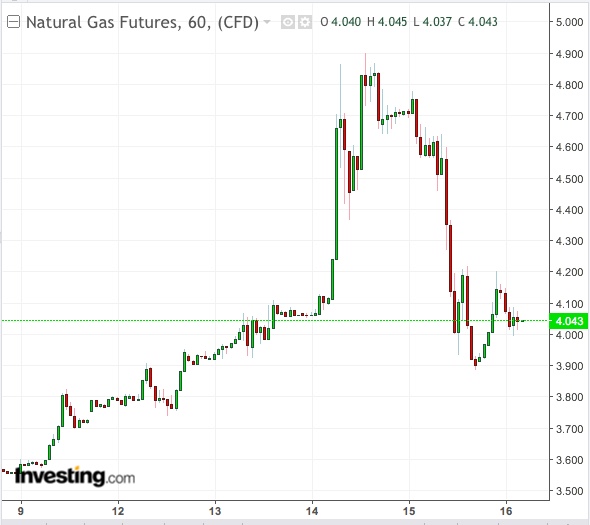There's no doubt volatility is back in US natural gas futures, after they posted an 18 percent rally one day and 17 percent plunge the next. What few have a clue on though, is where prices are going next.
Will the market break above $5 per million British thermal units—a level that would be commensurate with the pre-winter freeze and intense cold between December and February that some gas bulls are forecasting?
Gas in reserve for winter 2018/19 is the lowest in five years and frigid weather like that seen during the epic polar vortex of 2014 could lead to runaway demand for heating. But there’s also speculation that, should the weather be warmer, the market’s bedrock of $3 per mmBtu since October might be untenable. This year’s extraordinary rally in natural gas has been accompanied by the constant refrain of gas bears that prices were going up too much too fast when cold weather has been sporadic at best.
Bears Score Psychological Victory
And the bears scored a psychological victory on Thursday when the market sold off brutally hours before the Northeast of the United States—the bastion of gas-powered heating—was blanketed by the first pre-winter snow storm of this season.

The front-month December gas contract on the New York Mercantile Exchange settled on Thursday at $4.04 per mmBtu, down 80 cents on the day, just as the blizzard hit. A day earlier, it jumped 74 cents. While natural gas is known as the ‘Wild West” of commodities for its bucking-bronco-like price swings, it has been at least four years since the market saw a price swing of 18 percent in a day.
Mike Seery of Seery Futures in Plainfield, Illinois, said in a note:
“The volatility in gas at the present time is extremely high and that will remain so for the rest of the winter months, as generally speaking we do not have price spikes in the month of November. But the weather has changed that situation quickly.”
Some Still Bullish, Calling Gas “Cheap”
Added Seery:
“I had been looking at a bullish position from the $3.10 level but unable to get executed as I missed this trade. However, I am still not recommending any type of bearish position as I still think prices look cheap.”
Dan Myers, analyst at Houston-based gas trading fund Gelber & Associates, concurs with that view.
In a note after Thursday’s market settlement, Myers wrote that despite the sharp decline, “bullishness remains with the market near $4. The change is largely a reversion in response to yesterday’s overzealous rally.”
He added:
“All in all, the market’s aggressive reaction to the recent cold weather and the sudden shift to withdrawals is a reminder of the risk and accompanying volatility that exists going into this winter with historically low storage.”
Five-Year Low In Reserves
Gas in storage currently stands 3.25 trillion cubic feet, after US government data on Thursday showed an injection of 39 billion cubic feet for last week versus market expectations for a build of 33 billion cubic feet. Despite the larger-than-expected injection, reserve gas for the 2018/19 winter is still 14 percent lower than the five-year average.
Notwithstanding the recent volatility, natural gas remains this year’s best performing commodity, with a year-to-date gain of 38 percent at Thursday’s settlement.
But it has also been one of the most difficult to read due to supply-demand peculiarities.
Huge volumes of gas, sourced from primary drilling and also obtained in secondary form during drilling for shale crude, has led to record output of the fuel in 2018—not unlike the situation we are seeing in crude oil.
$5 Gas Soon A Reality?
Despite such overwhelming production, storage levels of gas never got out of hand, thanks to first strong summer heat and, now, early cold that kept air-conditioners and heaters on overdrive.
While prices north of $3 per mmBtu had been the norm lately, the shock to the upside of $4 arrived this week when market bulls speculated on a colder-than-usual November. And suddenly, the market was at the cusp of $5 pricing.
Now, with another 3-1/2 months left to the cold weather cycle, the path of least resistance seems lower.
Bank of America-Merrill Lynch said in a note that due to lower inventories, it saw “potential for cold weather to propel winter NatGas to a brief price spike over $5 mmBtu” by first quarter 2019.
